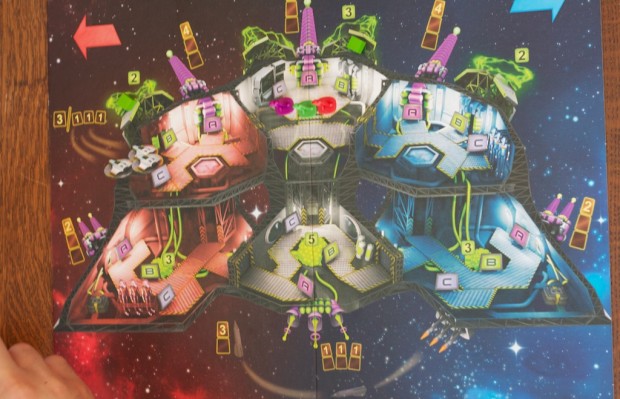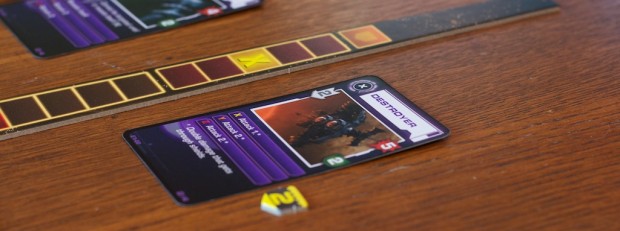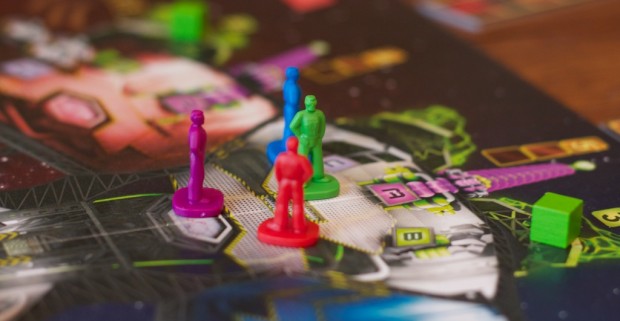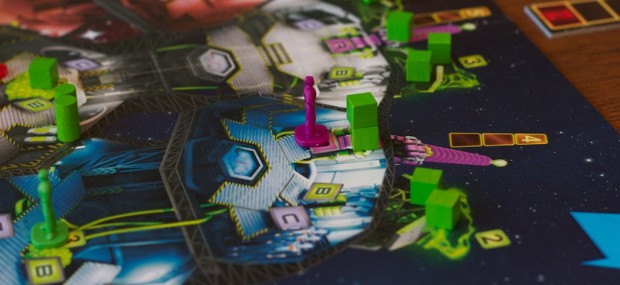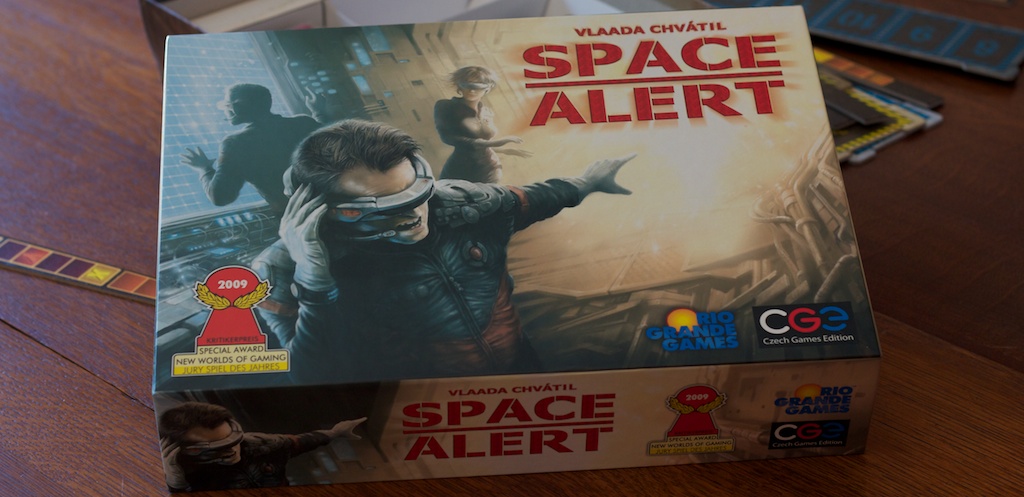
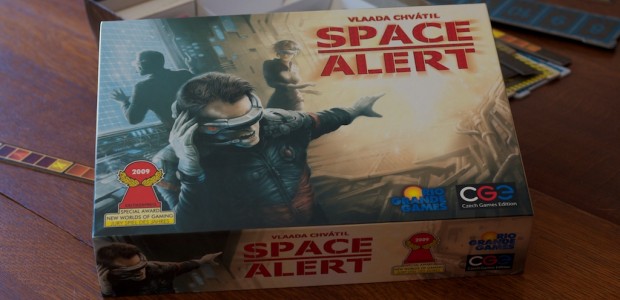
The general conceit for most board games is to have a relaxing time with friends, talking about the day while rolling dice and merrily going about simple objectives. I mean, sure, Monopoly is great…for sissies. So you want to step up your game where instead of lackadaisically pushing pawns around a board you frantically shout at friends while sweat pores out of your body as though it were a sieve? Well the game you need to be looking for is called Space Alert.
The story behind Space Alert is basically as follows: You and your crew – made up of recent trainees – are tasked with accompanying a “Sitting-Duck” Class vessel as it goes out in to space and attempts to collect data. The ship is great, except it’s not. Even though all of the processes for collecting this data are automated, it needs a full crew to manage every other system on board, else any threat presented could rip it to shreds. The mission at hand is for your intrepid team to watch over the ships systems as it comes out of hyperspace to grab this delicious, delicious data. The good news is that this will only take about ten minutes. The bad news is that during this entire time there are both internal and external threats that make surviving just a tad bit difficult. In space, no one can hear you scream, or so I’m told. I am sure your pals in the same room can hear the screaming right up until your craft explodes because you all suck at keeping it from not exploding.
Our awesome ship makes up the entirety of the main game board. The ship is split into three sections (red, white, and blue [GO ‘MERCA!]) and has an upper and lower deck in each of these areas. Basically, there are six zones on the ship for you and your crew to run crazily through while things shoot at you. To make it easy for the new recruits, each of these zones has but three controls to manage in the form of giant buttons: A, B, and C. Hitting A in any of the zones will shoot lasers at enemies; hitting B deals with shields or replenishing energy; and hitting C has a special effect depending on where you are in the ship.
At the start of the game, you and your pals are situated squarely on the upper center zone (the bridge) when – uh oh – bad things start to happen. You know of these bad things because of the included CDs with mission .mp3s on them. I wasn’t kidding when I said the mission takes about ten minutes. You don’t have a choice. During the game you will want to have a computer nearby or a phone/tablet with the .mp3s on it to play the selected mission. The game begins when one of these files is started, cueing your blood pressure to rise. Seconds after the game begins, threats start appearing on the horizon (more on that in a second), and you begin to plan on how to deal with them without wetting your pants.
The gameplay itself consists of using cards (that display both a movement and an action) within turns that exist in three sections. That sounds confusing, so lets break that down. In front of each player is a track with card-sized rectangles with the numbers 1-12 on them, denoting the turns. Those turns are broken up in three sections, and those sections are turns 1-3, 4-7, and 8-12. When the game is running, you can only play these sections when instructed to do so by the computer with cards that have been placed on each of the sections.
Now, the cards themselves have two halves like just mentioned. One half will be a movement, and the other an action. The action just boils down to pressing one of the buttons for the most part. Each turn represents one time frame, so while the game is running you coordinate where you are and what you are pressing by laying down the cards (face down!) on the turn track as you go. For example, let’s say that you need to get to the upper blue section from the bridge to shoot the laser there. You see that in your hand you have a movement-right card and another card with A listed as its action. For turn 1 you would place the movement card face down with the movement on the top of the card. For turn 2, you’d do the same, but with the A on top. And that’s basically how the game is played through the 12 turns.
Additional to the main board are three trajectory tracks that sit out in front of the ship. The computer will instruct you and your crew when threats show up by saying “T-minus 3, white,” for example. This tells you that a threat will show up on the white section of the ship on turn 3. Someone on your team is designated as the “communications specialist” that is supposed to be paying attention to these alerts and placing enemies where they are supposed to go at the right time. The enemy card is pulled from a stack when these threats are called out, and the cards display how fast they move and how much hit-points they possess in addition to shields if they have any. There are spaces on each trajectory track that get closer and closer to the ship. Some of these spaces are labeled X, Y, or Z, and if a ship gets to or passed one of these spaces, it attacks based on what its card says. Mostly that’s just shooting lasers at you, but other times it can be simply destroying your whole ship. Goody. And the best part about threats is that when the heat is on, it’s very difficult to coordinate with everyone where the enemy is and who has or has not killed it.
“That doesn’t sound hard, just have someone mash A until things explode.” Well, that’s what you would LIKE to think, buddy. With each press of A on the top deck, you drain one energy from that section’s reserve. Red, White, and Blue all have energy reserves that are used for shields and lasers. When Red or Blue’s (the outside sections) energy is depleted, someone can press the B button on the lower portion of that section to pull more energy from the main reactor in the bottom center of the ship. When the center runs out of juice, someone has to spend a reactor core to get more. So while the idea of “just mash A” is a great one, you have to make sure that you mashing A doesn’t affect the guy redoing the shields, and someone has to make sure all the reactors have energy. And one person shooting too early or grabbing energy too late can mean the difference between winning and losing.
“But how exactly do you know if you won?” See, that’s the greatest part. During all of the shouting and figuring out where people are going, you don’t have time to really plan for every contingency. You just hope that what you did will not get everyone killed. Once the ten minutes are up, or the .mp3 has stopped playing, you reset the entire game from the starting position and go through everyone’s movements one by one to see how it all played out. While that may sound boring, it actually can create quite an intense atmosphere in the room. You all have just come out of ten minutes of alarm bells with space octopuses grappling your ship. You though you did super well, but then upon “reviewing the tape” you realize that Bob shot at the spoctopus too early on turn four, but he didn’t even show up until turn six. That feeling of defeat but cautious optimism for the second half of the game is great. Bob screwed up early on, but Tammy said she shot at the thing on turn nine. Maybe you didn’t die after all! To win, in the end, is to have at least one person still alive and your ship not destroyed. FOR SCIENCE!
Space Alert certainly isn’t the most simplistic board game out there, but that proves to be one of the most fun parts when the action starts. Not mentioned in this review is what button C really does, which can be anything from summoning battle-bots for inside threats, shooting missiles instead of lasers, or moving the mouse on the ships computer so the screen saver doesn’t come up. If the screen saver comes on, the lights go out, and everyone’s turns are moved back one full turn. Lovely. There are quite a few other little quirks about the game that would take a bit to explain, but the point I want to get across is to not be overwhelmed with all this bulljive that’s going on. The game does do a good job of easing your toes into the water with set-up missions that make things a lot slower, so don’t worry about the tiny-fonted, thicker-than-you’d-expect booklet when you open the box.
So should you try Space Alert? Yes. Yes you should. Average games only last about 20 minutes or so, and the whole time you will be fearing for your life aboard this crappy, crappy ship. It’s great.
Space Alert can currently be had at Amazon for about $44. 1-5 players.
